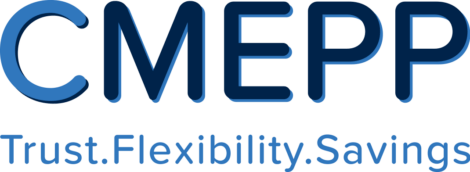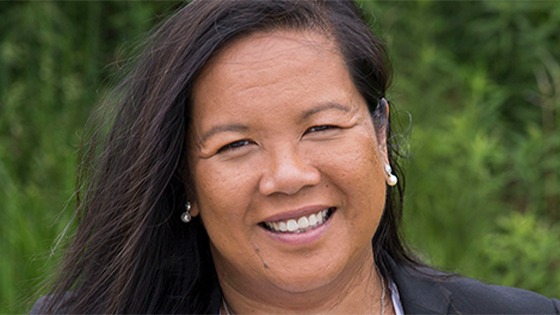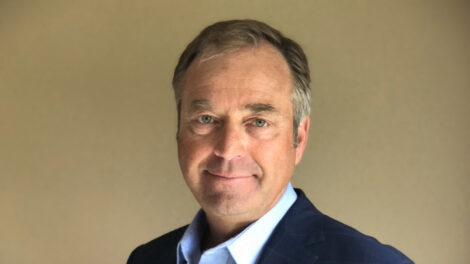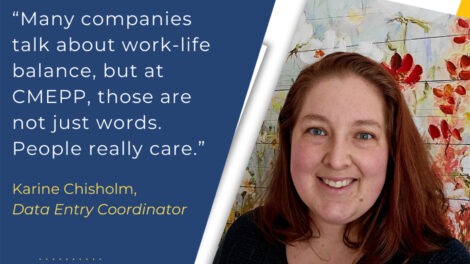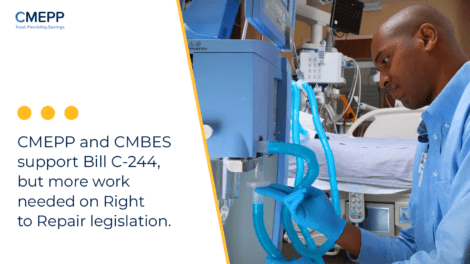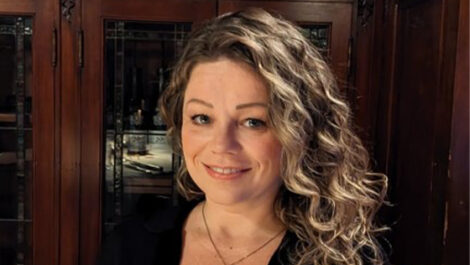In her colourful career journey, TransForm SSO CEO Noralyn Baluyot has learned that striving for good enough, not perfection, is a more satisfying goal, especially during a crisis.
In this conversation with CMEPP, Lyn talks about moving beyond the pandemic, and how she’s focused on creating a higher profile for TransForm with its unique focus on healthcare supply chain services and IT.
Lyn, you’ve had a fascinating career trajectory. You started in nursing, moved into administration, and transitioned into healthcare consulting. How did those experiences prepare you for what you encountered when you got to TransForm?
Starting out being a frontline staff and moving into administration gave me an understanding of the way things work in a hospital. I get what it means to deliver patient care and the complexities surrounding it.
In terms of consulting, I think it gave me other reference points that I don’t think a lot of administrators and other folks embedded in our health system have. I’ve worked in all four corners of the United States and in Australia; I’ve worked with clients who have been in Asia as well as in Europe. I’ve been fortunate that I’ve seen the good, the bad and the ugly of a huge variety, which, in turn, helps me to apply the lessons learned from those experiences.
I wonder whether having those experiences has made you more of a bold thinker and a believer that dramatic change is possible. One of the examples cited in the material I read was the Cerner Millennium Hospital Information System – you made that happen and you did it during the pandemic. What is it that’s helped you become a bold thinker like that?
First off—it was a massive team that made the project happen. The leaders at each of the organizations contributed to the success of the project. With the Cerner project, my job was to keep everybody focused on the bigger goal that we were trying to achieve, which was implementing a regional information sharing system across four hospitals.
Having a clear and consistent vision that everyone has signed off is key. You can’t falter from that or they’ll be quick to say “well, let’s do it another way” and diverge from the original goal. Because of my previous experiences and provincial and global relationships, I was able to show our sites, “Look, other hospitals have gone that way, so can we.”
Another part of it was being pretty blunt and saying to people, I am going to be asking you to do something really hard. Let’s talk about how we’re going to get around the obstacles rather than try to soften the blow. Too often we don’t recognize how hard the change is going to be for people and we try to couch it in niceties. Being straightforward and understanding the issues is key to success.
What was the toughest thing about that project Lyn? What did you learn about yourself going through that?
Even before the pandemic started, we knew something was happening. I had a meeting with my supply chain team back in October/November and they told me ventilators are back-ordered by four months. They told me factories are closing down and what’s happening in China is going to have huge impacts on the supply chain.
That was five months before the pandemic was announced. We started doing scenario planning. “What if there is a pandemic?” “What if the supply chain issues continue to spread?” “What if we have to stop this project for whatever reason?”. I had a team of over 100 people hired just for this project. Am I going to have to lay off 100 people? How do I continue with this project?
Trying to frame that decision and how I was going to bring it to the executives who are paying for the system was probably one of the hardest things I’ve had to do because of the regional impacts to both the health system and people. I realized, as lot of people through the pandemic did, there isn’t only one way to get to an end goal. We had to learn that pretty early on and be okay with it
It also meant being okay with making decisions with imperfect data. In the end, the go-lives happened at different times, but they all happened—they went incredibly well despite the challenges, and we were only off our original schedule by four months. Considering the pandemic lasted over two years in varying degrees of lock downs and restrictions, I would call this a success.
What I hear is that healthcare leaders had to have a flexible approach because you couldn’t go by the old rule book, nothing was working. Do you think that those were some of the ingredients that made some healthcare leaders more effective during that time?
I think so. The healthcare leaders who became more comfortable making decisions with imperfect information were actually able to be effective in ambiguity. Whereas those more risk adverse leaders who need to know 100% of everything before they’ll make a decision, probably really struggled initially with the volume and speed at which decisions had to be processed. You didn’t have time for that.
I do think a lot of leaders suffered from decision fatigue, including myself. There got to be some days where I couldn’t make one more decision. When you’re getting hit with a gazillion things at a time, you’re thinking, what do I do next? How do I move us forward? It’s recognizing that decision fatigue is real. And that you need to make sure that you and your team get a break from having to make those decisions—self-care is very important if you are to be an effective leader.
We’ve entered a different phase of the pandemic now, the return to work. Leaders are confronting issues of retention and giving workers more flexibility. How are you handling those decisions and those kinds of tough conversations?
The words do matter and it’s not return to work, it’s a return to the office. It’s also realizing that a single solution is not going to fit everybody in our organization. We tried that in the spring, telling people to come into the office for two to three days and then you can work from home. Our team rightfully asked the question, “If I was able to be effective in my job for two years working from home, why do I need to come into the office??
So I took a step back and decided I’m going to work with the managers. The managers will figure out what works best for their team. You still have to be productive, you still have to be able to do your job, you have to make sure your team feels connected – but at the end of the day, you make the decisions. The pandemic was a period of time where we had to make decisions really fast. Things are different now and we can take the time to collect information before landing on a permanent solution.
We’re also looking at different work models. A lot of people are saying they want a four-day week, so we’re to try to figure out if it can work. Doug Ford has implemented the Right to Disconnect. Well, when you’re in healthcare IT and healthcare, period, and you’re providing that layer of support 24/7, can I actually do a right to disconnect? If I can’t have people disconnect 100%, can I at least model what it means to disconnect when you’re not needed all the time?
What’s your advice for leaders on creating strong teams?
I think one of the big things with teams is you have to foster really open, honest dialogue and transparency. And that starts with you as a leader. Your team might not know all the details because some things do have to be kept confidential for whatever reasons, but they do have to be aware of the parameters under which you may be making a decision.
When you are transparent with your decisions and decision-making process, it also gives people permission to be transparent as well. This goes back to what I said about bluntness – there are times when you need to get your point across and have those crucial conversations.
I think the other piece, and it’s something that the hospitals all over the world have been trying to adopt, is the no blame culture. That it’s truly okay to make mistakes because we learn more from our mistakes than doing something 100% correct the first time. And mistakes will happen. Figure out what led to that mistake without saying ‘so and so caused all these issues’. By understanding that it’s okay to make mistakes, you also give people permission to try new things. In our team meetings, I’ve stated multiple times that if we aren’t failing a lot, we aren’t trying new things.
What’s the best career advice you’ve ever received Lyn?
So two things, and they both actually came from the same individual. Early on in my consulting career, I was working out in California for a chief medical informatics officer and he said one thing to me, “Do you realize you don’t look people in the eye, Lyn?” I said no, I’d never realized that. He goes, “As an Asian-American Filipino and as a female, you’re not taught to look somebody straight in the eye when you talk to them. As uncomfortable as it is, you’ll need to learn how to do it.”
I was grateful that he was willing to have that conversation with me and he would make me practice with him all the time.
His other piece of advice was, if you try to strive for 100% perfection all the time, you’ll be constantly disappointed and you’ll be exhausted. You have to recognize when 80% is good enough. Then he added, “That’s not just in work, that’s in life.”
He’s been absolutely right. Being a wife and mother of three children while working in various careers, I’ve learned that good enough is not a bad thing. Good enough lets you move forward.
Can you tell me how TransForm benefits from its partnership with CMEPP?
I think that because CMEPP creates that shared pool of funds for all the participants to help support service repairs, it does reduce the risk for all the healthcare organizations that participate in it. This helps us all when it comes to our annual repair costs, as well as returning surplus back to the membership.
Just to expand on that, one of the things that I’m realizing is that in Ontario, we don’t take nearly enough advantage of the benefits of consolidation of health systems and the negotiating power that would bring.
TransForm is able to do that on behalf of our five member hospitals and our membership. I also chair the Cerner Collaborative and we’ve been able to take advantage of that when we bring the power of the 10 Cerner instances (representing over 50 hospitals) together to negotiate with Cerner and think about how to do business differently in Ontario.
But we don’t do that enough. We should all be coming together and saying, look, we want the best deal for all of us. We’ll have a better shot at it if we can figure out how to collaborate in the same way that CMEPP does. What we’ve learned from CMEPP is the power of working together to get the biggest value for our dollar.
Lyn, there are a lot of things that I’m sure you’ve had to confront in your new position and I’m wondering, what are you looking forward to over the next year?
I think solidifying who TransForm is in the overall Ontario health ecosystem. Not everybody is 100% clear on whom Transform is and the value we can bring. It’s also important that people recognize what we’ve been able to accomplish in the Erie-St. Clair region.
I want people to know that we play a role in helping organizations figure out how to be sustainable. There are other shared service organizations that focus only on supply chain, but there aren’t any that do both supply chain and IT services like we do. IT services are expensive and finding the staff to support IT systems is really hard. So if you’re a small to medium-size hospital, that’s a very costly business for you to be in and you could be sharing services with another organization. TransForm does it for the five hospitals down here and there are clear benefits to that.
That’s what I look forward to, defining that very crisply and cleanly so that others can recognize it and we can truly leverage what we’ve been able to do, sharing our learnings with other organizations so that they could avoid some of the issues that we have experienced. Not only just for Erie-St. Clair, but other partners as well.
